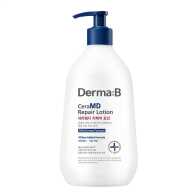
Derma B Cera MD Repair Cream is a product with 35 ingredients. Contains: Vitamins - Panthenol; Antioxidant - Vitis Vinifera (Grape) Seed Oil, Olea Europaea (Olive) Oil;
Organic score: 43% natural, 43% chemical. Vegan - No; Cruelty free - No; Reef safe - Yes;
Positive effects
Concerns
INCI - Full Breakdown
Water is a great solvent. It’s neutral and doesn’t provide any strong positive or negative effects. It just helps components to mix better and to transport active components.
Cetearyl Alcohol is used mostly for formulation purposes. It’s a very good emulsifier and emulsion stabilizer. It helps the ingredients mix better and it makes the product spread on your skin evenly. It also makes the product thicker. It doesn’t belong to harmful alcohols and it will not dry your skin.

Glycerin is one of the most outstanding and helpful skincare components. It's used in many skincare products because it works and provides notable results. It's one of the best moisturizers. Molecules of Glycerin can absorb water and deliver it into deep layers of the skin making it hydrated.

Butylene Glycol is a very popular synthetic alcohol. It helps the product to absorb deeper and faster. It is also a solvent for other ingredients. As for the skin benefits, it helps to attract water and helps to make the skin softer.
Shea Butter is a great natural moisturizer everybody knows about. And it’s popular for a reason. It contains 5 essential fatty acids (palmitic, stearic, oleic, linoleic, and arachidonic), vitamins (A, D, E, F), and catechins, which are antioxidants. It moisturizes the skin and protects it from UV, cold, and other negative factors. It can be used on its own and will not harm your skin even in very high concentrations.

Stearic Acid doesn’t belong to aggressive acids. It’s a fatty acid that can be found in Shea Butter, Cocoa Butter, and many natural butters and oils. The component is mostly used for formulation purposes. It makes the product spread and feel better. It’s one of the most important fatty acids in our skin cells.
Dimethicone is the most popular silicone. It makes the skin softer and forms a film adding smooth and silky feeling. This film not only improves how the skin feels but also works as a protective barrier. It also improves the visual appearance of your skin by filling small wrinkles. That's why some people think dimethicone removes wrinkles. Actually, it does not. It's just a visual effect.
One of the most important characteristics of this component is that it helps to spread other ingredients evenly on the surface to provide good coverage. It's very important because you want all your skin cells to receive an equal proportion of the components.
Dimethicone is considered as safe, but remember that it is rather difficult to wash off! This may lead to clogged pores and acne if you use it too often and don't wash off quite well.

Glyceryl Stearate SE is a nice moisturizing ingredient. It hydrates the upper layers of the skin and fills small wrinkles. In haircare products, it's used for making hair softer.
Functions
Reviews
The product doesn't have reviews. Be the first to share your experience.









